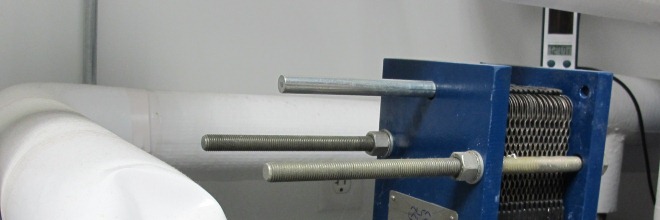What is District Energy?
District heating systems produce hot water, steam, or chilled water at a central plant and then distribute the energy through underground pipes to buildings connected to the system. Individual buildings connected to district heating no longer need boilers or to maintain redundancy for heating needs. Customers use the thermal energy provided by Duluth Energy Systems to meet their space heating, water heating, and process heating needs.
How does the steam system work?
The City’s district heating system started providing heating services to the community in 1932, when it was designed as a once-through steam system. Energy is delivered to customers through these steps:
- Inside the main Duluth Energy Systems plant, boilers produce steam by combusting fuels (predominantly natural gas, with future potential for biomass/biofuel).
- Water is heated to 360℉ to create high-pressure steam.
- The steam is distributed to over 160 buildings downtown through a series of underground pipes.
- In many buildings, the same steam produced by the plant is circulated through the building HVAC equipment to heat office spaces and living areas.
- As these buildings use the steam, it cools and condenses back into water (condensate) at a temperature of approximately 180℉.
- The condensate is then discarded into either the storm sewer or sanitary sewer.
- Although once state of the art, modern district energy systems have transitioned to the use of hot water as the heating medium, replacing steam.
How does the hot water system work?
Canal Park and many customers along Superior Street are served by the hot water district energy system.
- Hot water (190℉ – 220℉) is produced at the main Duluth Energy Systems plant by transferring the energy in the steam to the hot water closed loop system through an energy transfer station located in the plant.
- This hot water is then distributed to buildings through a system of underground pipes.
- Once the water reaches the building, it transfers heat to the buildings separate hot water loop through an energy transfer station located in their building.
- Hot water in the building loop is then used to heat domestic hot water and in HVAC equipment to heat building spaces.
- After customers use the energy they need, the water is returned to the central plant to be reheated and then recirculated to customers through the closed-loop piping system.
- This system operates on a continuous basis.
How is hot water more efficient?
The closed-loop hot water system operates at a lower temperature than the steam system. The lower the temperature of the heating medium, the lower the heat losses. This is due to the temperature difference between the heating medium and the surrounding air temperature and the rate at which the heating medium cools. The greater the difference, the faster the heating medium will give up heat, which is energy.
In the closed loop hot water system, the hot water from Duluth Energy Systems heats water in the customer buildings through an energy transfer station. The hot water that flows through HVAC equipment in offices or living spaces is separate from the hot water in the Duluth Energy Systems hot water loop. Heat that is not utilized in a customer buildings is returned to the Duluth Energy Systems plant to be reheated and pumped back into the hot water loop. The closed loop system results in water savings. In an open loop steam system, no water or steam is returned to the plant, and it is cooled for discharge into the storm or sanitary sewer.
The water that is returned to the plant in a closed loop hot water system is significantly warmer than the make-up water for the steam system. This also increases the efficiency of the system as it takes less energy to reheat warm water to supply temperature than it does to bring cold water to supply temperature.
